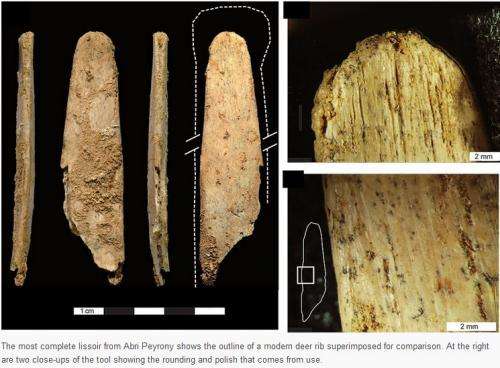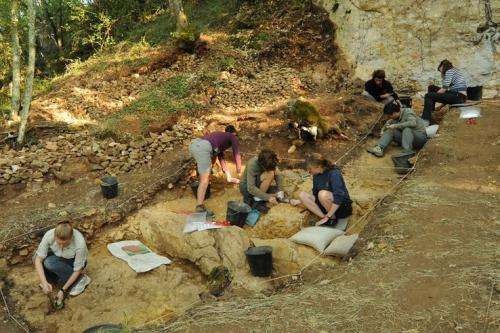Research finds Neandertals, not modern humans, made first specialized bone tools in Europe

One day in 2011, undergraduate student Naomi Martisius was sorting through tiny bone remnants in the University of California, Davis, paleoanthropology lab when she stumbled across a peculiar piece.
The bone fragment, from a French archaeological site, turned out to be a part of an early specialized bone tool used by a Neandertal before the first modern humans appeared in Europe.
"At the time, I had no idea about the impact of my discovery," said Martisius, who is now pursuing her doctoral degree in anthropology at UC Davis.
Martisius' opportunity was the result of a decade of excavation and research by two international teams. Their findings were published in the Proceedings of the National Academy of Science in August.
"Previously these types of bone tools have only been associated with modern humans," said Teresa E. Steele, associate professor of anthropology at UC Davis, who also served as a co-author on the article and adviser to Martisius at UC Davis and at archaeological excavations in France.
"However, our identification of these pieces in secure Neandertal contexts leaves open the possibility that we have found, for the first time, evidence that Neandertals may have influenced the technology of modern humans," she said.

Used to smooth tough animal hides, the tools were made about 50,000 years ago by Neandertals—not just the humans who came after them, as researchers had earlier theorized. The specialized tools are still used today, in similar form, to smooth and refine leather made into high-end purses and jackets.
The bone tools were found in deposits containing typical Neandertal stone tools and the bones of hunted animals including reindeer, red deer and bison. Three of the four pieces were from the site of Abri Peyrony, France. The animal bones from that site had been exported to UC Davis for analysis in Steele's lab where Martisius worked with her to study the material.
Now in her second year of doctoral studies at UC Davis, Martisius will carry on her research of these pieces. She, Steele and their colleagues will use resources available at UC Davis to conduct experimental studies to manufacture—and use—new, similar animal bone tools for comparison.
Using sophisticated imaging techniques, Martisius will examine the pieces made by the Neandertals, comparing those with the ones first made by the first modern humans in Europe and the ones she manufactures at UC Davis. She said she also will look at animal bones from nearby sites to see if she can identify additional pieces made by Neandertals.
The tools described in their current work were recovered in archaeological sites in the French countryside that had been explored for more than 100 years, but modern archaeological techniques enabled researchers to recognize these smaller pieces now identified as pieces of once-sophisticated tools, Steele said.
The article, "Neandertals made the first specialized bone tools in Europe," is available online.
More information: www.pnas.org/content/110/35/14186.full
Journal information: Proceedings of the National Academy of Sciences
Provided by UC Davis

















